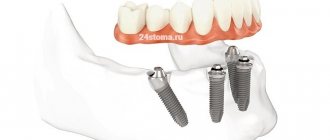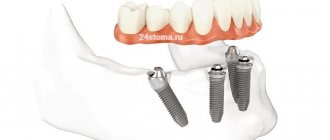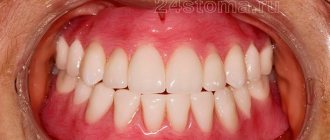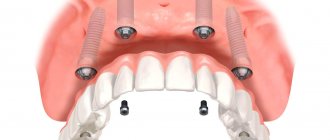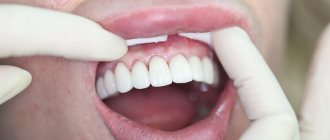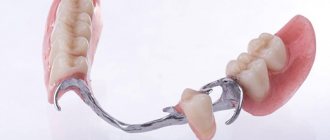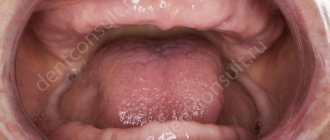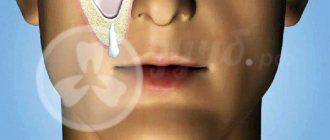A quick review of dental content on the internet reveals a grossly inequitable distribution of useful information about dental implant restoration.
Many people write about implantation, implants, various surgical techniques for restoring gums and bone tissue, but there is very little information about implant prosthetics, making crowns, and stages of prosthetics. We decided to correct this injustice. Therefore, today we will tell you about what happens to implants from the moment of integration and the stages of their prosthetics. Important note! The purpose of this article is to show all aspects of prosthetics as a stage of dental rehabilitation using dental implants. It’s a no brainer that this cannot be done within the framework of one clinical case and one implantation system. Therefore, to create this publication, we took the most important and revealing stages from different clinical cases with different implantation systems. Please be understanding about this.
What are implants and implantation
An implant is a structure that imitates a tooth root. It is implanted into the bone tissue of the jaw to create support for subsequent dentures. Implantation is a surgical operation during which an implant is fixed into the bone. If the patient has a lack of bone tissue volume or density, then an operation is first performed to eliminate the defect, which is called osteoplasty. The period during which the artificial root is implanted is called osseointegration.
Implant-based dentures are literally “fundamentally” different from standard dental orthopedics. The fact is that the crowns, “bridges” and removable orthopedic structures that are familiar to us are only an imitation of the upper (coronal) part of the natural dental element. A prosthesis on an implant is a complete replacement. Consequently, this method of recreating the integrity of the dentition not only restores the chewing functions of the jaw apparatus, but also prevents atrophy of its bone tissue. And a decrease in bone volume leads to irreparable consequences: all dental elements are displaced, the chewing load is unevenly distributed, and the symmetry of the face is disrupted.
Stages of one-stage implant installation
One of the options for one-stage technology is the installation of a root substitute in place of a newly extracted tooth. In this case, both operations are performed simultaneously, that is, in one visit.
How to install a dental implant step by step immediately after tooth extraction:
- The dental surgeon removes the problematic unit from the socket in the least traumatic way.
- An implant is installed into the resulting cavity.
- Bone material may be used to improve screw stabilization.
- A former or temporary crown is fixed on the implant.
Single-stage implantation makes it possible to minimize the number of surgical procedures, and the time for tooth restoration in this case is minimal.
Types of prosthetics on implants
The implant can serve as the basis for any type of dentures. The installation of any particular one depends on the conditions of a particular clinical case. The orthopedic structures that can be fixed to the artificial root are the same as those used in the standard denture option. If one tooth is missing, then one titanium rod is implanted and a crown is put on it. If there are not several in a row (up to 5 units), then 2-3 implants are installed, and a bridge-like prosthetic structure is already fixed on them. When the patient is completely edentulous (all teeth are missing), then the technique of installing a complete denture on 4 or 6 implanted implants is used.
Note: the optimal option for dental prosthetics in each specific clinical case is determined by the implantologist after conducting visual and hardware diagnostics. Our network of clinics is equipped with modern high-precision diagnostic equipment, so we can determine the strategy for dental prosthetics and calculate its cost during one visit.
Stages of prosthetics.
At some point, usually 3-4 months after the implant surgery, we check the integration of the implants, take control photographs and create the primary gingival contour using special components called abutments.
And, if everything is in order, after a week or two, the patient is sent to an orthopedic doctor to have dentures made.
At this stage, the main task for the doctor is to transfer the exact position of the patient’s implant to the model. This is done using the so-called. “transfers”. The transfer is fixed to the implant instead of the gum former. Then, an impression is made using silicone mass, and the transfer remains inside it.
The usual impressions are sometimes replaced with 3D scanning of the oral cavity, and instead of transfers, special scan heads are used.
This does not change the essence - the exact position of the implant is transmitted to the dental technician through an impression or a three-dimensional virtual model. All other stages of making your new teeth take place not in the clinic, but in a dental laboratory.
We will talk about them in the next article. The most interesting things are ahead, and this is a reason to subscribe to our website and pages on social networks.
Best regards, CLINIC IN.
What else can you read about prosthetics at CLINIC IN?
Section “Dental prosthetics” on the CLINIC IN website
Section “Dental implantation” on the CLINIC IN website
You are scheduling a consultation at CLINIC IN. What do you need to know before visiting the dentist?
Consultation with an implantologist
You are planning dental prosthetics. What do you need to know about this before consulting a dentist?
Advantages of dentures on implants
- No need to grind down healthy teeth
- Lifetime service life (the crown part can be replaced if necessary)
- Complete restoration of chewing function (without restrictions)
- High aesthetics
- Easy hygienic care
6 stages of prosthetics using classical implantation
1 Diagnostics
Assessing the characteristics of a clinical case, identifying indications and contraindications for implantation. Determining the relevance of osteoplasty
2 Preparatory
Sanitation of the oral cavity. Osteoplasty – if necessary
3 Implantation
Surgery to install a titanium root into the patient's jaw bone tissue
4 Osseointegration
Period of implantation
5 Preparation for prosthetics
Installation of abutment and healing abutment
6 Dentures
Fixation of permanent dentures
Stages of classical installation of dental root substitutes into bone tissue
Previously, a metal screw was installed in the jaw in only one way - in two stages and with delayed loading of the prosthesis. Today other methods are also used. But this technology is considered classic. When using it, the step-by-step procedure for installing dental implants is as follows:
- First surgical stage. The gum is cut, a bed is drilled into the bone, into which the dental implant is inserted. It is then closed with a plug and the tissue over it is sutured. The entire installation takes 20–30 minutes.
- Second surgical stage. After 3–6 months, the mucoperiosteal flap is cut again and a healing abutment is installed instead of a plug. This operation lasts 15–20 minutes.
- After two weeks, the former is removed and an abutment is installed in its place. This manipulation takes on average 10 minutes.
- Using impressions of the jaw, after 7–10 days a crown is made, which the orthopedic dentist fixes on the abutment.
Thus, the entire time scheme when working according to the classical method takes approximately 4 to 7 months.
Care of prosthetic structures on implants
Hygienic care is not difficult, but must be carried out regularly and carefully. This is the only way to hope for longevity. Obviously, during care, the implants themselves are not cleaned, since they are located in bone tissue. Only the supragingival part of the dentures needs to be cleaned twice a day. This should be done with a toothbrush and toothpaste. Dentists also recommend using an irrigator for care - a device that cleans the tooth surface with a jet of water directed under pressure. This ensures that food debris is washed out from the most difficult to reach places between the teeth.
If the denture is removable, then it must be regularly removed, cleaned and treated with a special solution that can be bought at the pharmacy. If the structure is conditionally removable, then you cannot do without the help of a dentist. The doctor will remove it, treat it and put it back. You need to contact the clinic for this procedure approximately once every six months.
Important: oral hygiene should not be neglected, especially if you have implants. The presence of pathogenic microflora in the mouth can provoke infection of the internal tissues of the gums and bones. In this case, implant rejection may occur.
The network of dental clinics “Smile” offers patients prosthetic services on implants. Contacting our branches has many advantages:
- implantation and prosthetics are performed by highly qualified doctors;
- all manipulations are performed in accordance with international standards;
- family and cumulative discounts are provided;
- pricing of services depends on the characteristics of the clinical case and the cost of the implantation system;
- We work according to a schedule convenient for patients: every day until 21:00 (on Sunday until 16:00).
You can make an appointment at any of the branches of our clinic in Moscow, located within walking distance from metro stations:
- Alekseevskaya (VDNKh district, etc. Mira), address: st. 3rd Mytishchiskaya house 3, building 2;
- Shelepikha, address: Shelepikhinskaya embankment, address: building 34, building 1.
The accumulated experience, the use of the latest technologies and modern equipment allow us to quickly diagnose and successfully perform dental prosthetics on implants, regardless of the complexity of the clinical case. We guarantee the safety and effectiveness of the services provided. We will restore the attractiveness of your smile!
– NO ONE NEEDS IMPLANTS WITHOUT CROWNS.
The purpose of implantation is to create a durable, most physiological and reliable support for a denture. In order to achieve this goal, two points must be completed:
1. Have an idea about future prosthetics and its plan.
2. Based on the prosthetic plan, place implants of the required size in the desired position (implantological rule #2).
The tasks for the first point are performed by an orthopedic surgeon: he selects the optimal prosthetic scheme for you, taking into account a number of physiological parameters and, of course, your wishes. In good clinics and in the presence of a well-coordinated and competent team of dentists, the orthopedist is not concerned about the very possibility of installing implants, the presence/absence of bone tissue volumes, etc., since all this can be recreated using various methods of bone and gum augmentation. Which is already the task of the implantologist.
In general terms and depending on the clinical situation, you may be offered the following prosthetic schemes:
Based on the prosthetic plan, an implantation scheme is formed, the sizes of the implants and the places for their installation are determined. This requires good and clear communication between the prosthodontist and the implantologist, plus adherence to positioning rules (see Recommendations for implantation, part V). In our clinic, orthopedists also help you choose an implant system that is suitable for your clinical case, since a correctly selected macro-design of an implant can significantly facilitate and reduce the cost of prosthetics. It is for this reason that we have set a fixed price for the installation of any implants.
The easiest (but not the cheapest) way to avoid mistakes when positioning is to use surgical templates:
They are also made by an orthopedic doctor and, in fact, repeat the future prosthetic design.
Surgical templates are either bone or supragingival. The first, more accurate ones, are often used to “bypass” some anatomical obstacles - maxillary sinuses, nerve trunks, etc. The second simply orient the implant along the axis with a known error, which allows osteoplasty, tooth extraction, etc. simultaneously with implantation.
Thus, dear friends, when planning and carrying out implantation
An orthopedic doctor is the most important and most necessary doctor.
Implantological treatment, dental rehabilitation using dental implants, begins with a consultation with an orthopedist . And not an implantologist, as many people think.
The easiest way to imagine this stage of preparation for implantation is to compare it with building a house.
Imagine that you have a plot of land and lots and lots of extra money. You want to build a house. Where do you start?
Probably, for starters, you will invite a surveyor and some geological topographical engineer. They will mark your site, determine the nature of the soil, the groundwater level and give you a conclusion whether it is possible to build something on it at all. And, if possible, what size? In fact, this is the diagnosis and examination that we conduct at the very beginning of any treatment.
Then, you will invite an architect who, using the data received from surveyors and geologists, will design your future home. When planning the number of storeys, the number of bedrooms and bathrooms, he will be based, among other things, on your wishes, lifestyle, etc. And, if you are dealing with a good architect, he will never provide you with an uncontested project - you will always have a choice and the ability to make adjustments. This is exactly how prosthetics are planned.
At the next stage, the project of the future house is transferred to an engineer, whose task is to calculate and construct the foundation. It can be completely different, but it must be reliable and technologically related to the design of your home. If you are planning to build a wooden country house, a simple pile or strip foundation will be enough, but if you plan to build a skyscraper, then the support of your modest Trump Tower should be appropriate. In our case, this is the implantation planning stage.
We do not know a single person who, having first poured the foundation, would call an architect and demand that he build the house of his dreams on this foundation. We do not know of a single construction organization that would start building a house without a design and the necessary geodetic and geological surveys. But, alas, in implantology and prosthetics this approach is very common, and a violation of the sequence of decision-making is one of the main causes of errors, complications and subsequent disappointment for patients.
When all the plans have been drawn up, the decisions have been agreed upon, and you have no questions left - you can begin installing the implants.
Brands producing compression implants
The dental products market offers implants with compression threads of the following brands:
- ROOTT (Switzerland);
- Nobel (Sweden);
- Straumann (Switzerland);
- Osstem (South Korea);
- Alpha Bio (Israel);
- and etc.
Each manufacturer conducts a lot of unique research, trying to study all possible aspects of implantation, successful and not so successful, to create an effective product. A lot of money and time are invested in this. New and improved Compressive products are released periodically.
For example, RUTT compression implants are represented in a wide range. Each type of product has a different abutment angle, pin length, type of notches, neck length, and grinding method. These are factors influencing the success of the operation. Combining different systems allows you to securely fix any prosthesis with minimal additional manipulation costs. In addition, RUTT compression implants are also available in multi-unit units, which allows them to be optimally used for All-on-4, All-on-6 prosthetics, and for toothless jaws.
Where to go for installation of compression implants
Compression implantation is combined with basal and others in a one-stage protocol. Compression thread allows these implants to be used in express implantation - a quick way to forget about dental problems. But you should contact trusted medical centers and qualified specialists. Accurate diagnosis and the optimally effective chosen treatment regimen play an important role.
Various dental clinics can offer services for installing compression implants. We have listed some of them in the table.
| Dentistry | Website | Address |
| ROOT Center | https://dentalroott.ru |
|
| Implant Ru | https://www.implant.ru |
|
| Smile-esthet | https://smile-estet.ru |
|
| Unident | https://www.6750000.ru |
|
| Center Family Dentistry | https://family-dental.ru |
|
Other jobs
Rehabilitation period
After implantation, it is important to follow the recommendations of doctors so that rehabilitation is as easy as possible:
- Do not eat for 2 hours or until the anesthesia wears off completely.
- Avoid eating hot foods for the next two days. Liquid or semi-liquid foods are recommended (avoid chewing or chewing food at the dental implant site until the wound has healed). Smoking cigarettes and drinking alcohol are also prohibited.
- Intense physical activity is not recommended for two consecutive weeks after dental implantation. Do not touch the implant or its immediate surroundings.
Swelling and bruising are a normal consequence of the dental implant procedure and disappear after a few days. They can be reduced by using cold compresses for 2 hours after the procedure. You should not clean the dental implant area for 10 days after the procedure unless your doctor recommends otherwise. The remaining teeth should be thoroughly cleaned. You should also not rinse your mouth for 8 hours after dental implantation, as this may cause severe bleeding.
Comparison with other implants
You can compare compression implants with the main types of implants:
- basal artificial roots for basal implantation. They are longer because... installation takes place in the distant dense membranes (bypassing the cancellous) bone. When using them, the volume of tissue is not important; the pin reaches the cortical layer. Allows you to avoid osteoplasty surgery.
- classic implants. They are universal, but the quality of the fabric is important, and compression ones are already used with an average degree of loss. A traditional root implant is used in single restorations.
- Dentists consider multi-unit implants with screw fastening to the prosthesis in cases of completely edentulous jaws. This system is more expensive, but allows you to remove/put on the structure to replace a part or service.
Advantages and disadvantages
Advantages of compression dental implants:
- stable fixation
- use for moderate tissue atrophy
- atraumatic implantation
- rapid osseointegration
- suitable for single-stage protocol with immediate loading
Flaws:
- not used for single restorations
- if there is a large loss of tissue, the tissue is not suitable (only basal implantation or osteoplasty)
Implantation is not performed during pregnancy, breastfeeding and under 18 years of age.
Does it hurt during implantation?
All procedures are carried out under local anesthesia, so the patient does not experience any painful sensations - he only feels the mechanical work of the doctor in the mouth, as during conventional dental treatment. In fact, the manipulations performed when installing an artificial root are less invasive and traumatic than when removing a tooth.
If you are very worried and are terrified of the upcoming operation, the clinic may offer implantation under sedation - in a relaxed state, but in full consciousness. The patient is given drugs that put him into a light sleep and he ceases to experience anxiety.
Complications - when should you see a doctor?
If you experience any of the following symptoms, contact your doctor as soon as possible:
- After the 3rd day of surgery, pain gradually increases
. It is quite normal to experience minor pain for the first 2-3 days, but no more. - On the 4th day the swelling began to increase with an increase in body temperature
. Normally, it should subside on the third day. If it grows, then there is a problem. - After 4-5 hours, the surgical wound continues to bleed
. Minor bleeding in the first 2-3 hours is normal. But you should be wary if the wound continues to bleed. - Part of the face became numb, and there were difficulties opening the mouth
. This is due to stretch/compression or injury to the nerve. It occurs very rarely (in less than 3% of patients) and is associated with physician error. - The temperature rose sharply to 39° on the fourth day
. An increase in body temperature to 38° in the first three days after surgery is a completely normal reaction of the body to surgery. But if after three days you notice a sharp increase in temperature, then you need to consult a doctor. - Purulent discharge appeared from the implant site
. This indicates the presence of an inflammatory process due to infection of the hole.
Installation options depending on bone type
Often screws are implanted not only in a vertical position, but also in the central spongy tissue. It is this area that is most susceptible to atrophic processes and resorption after extraction. It is not always possible to use this area during therapy; some dentists resort to extensions.
Manufacturers have developed models designed for attachment to other types of bone structures:
- Basal and compression. They are located in the deepest layers that are not prone to atrophy. A well-known, time-tested brand is Oneway Biomed.
- Zygomatic Elongated, mounted at an angle exclusively on the upper jaw. Such structures are characterized by reliable fixation without deformation.
Sanitation of the oral cavity
Implants can only be placed if the oral cavity is in ideal condition. The slightest hint of inflammation or infection can jeopardize the result of the painstaking work of many specialists - implantologists, orthopedists, dental technicians. If the wound becomes infected after implant installation, there is a high chance of developing re-implantitis and the entire structure will have to be removed. To avoid this, the mouth is sanitized at the preliminary stage:
- All teeth with caries are treated
- Treatment for sore gums
- Professional hardware hygiene in dentistry is performed.

